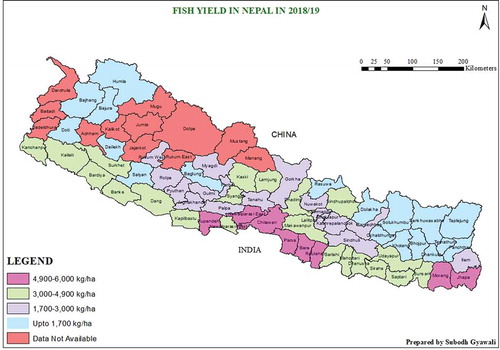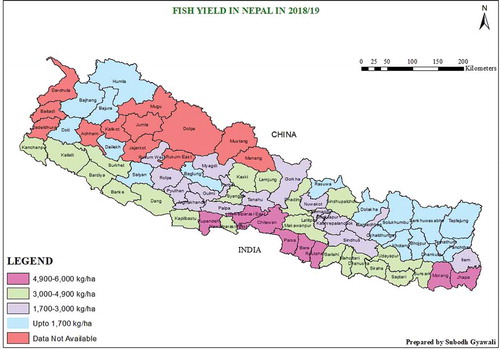Abstract
To ensure a food security in future for all, the fisheries sector is key. The world’s demands for fish products indicate sign of increasing. This study delves into the analysis of production, marketing, and strategies for enhancing production and marketing of the fishery products. Secondary data for production and trade value were collected from different organizations, websites, and journals and were analyzed in Microsoft Excel. Over the years, rearing of different fish species has been rising worldwide, including Nepal. Marine, along with inland fisheries is getting profitable market, globally. Being a landlocked country, Nepal’s fish farming is solely limited to inland water resources. So, the domestic fish production is very few which is unable to meet the national demand. The fisheries, at national level, remarkably expanded than the previous decades and total production, trade, and consumption reached an all-time record in 2018. It has provided employment to millions of people across the world. Still many challenges have often hindered the production and marketing. Climatic changes, technological constraints, disease outbreaks, water temperature fluctuations, high cost of inputs, marketing constraints such as unmanaged distribution networks, lack of storage facilities, etc., have lowered down the fishery development. Keeping this point in view, this review was performed to provide the relevant solution of production and marketing strategies to the fishery industry, helping them to enhance the production and make perfect level of distribution. Marketing mix of marketing strategies and SWOT analysis for both production and marketing was performed.
PUBLIC INTEREST STATEMENT
Though, being impoverished on any oceanic resources, Nepal has a worthy potential in the production of fish. With increased global population, the demand for food is also rising. One important food that needs urgent attention is Fish. However, despite the high production potential and importance of such fishery products, the marketing coordination is weak. In this paper, we assessed the production, prospects, and the marketing of fishery products in Nepal and globally. The authors recommend the concept of “Marketing mix” to embolden fish trade. SWOT analysis was performed to ease the researchers and Policymakers while making strategies and programs for the aquaculture development. The result indicated that fish is the superfood and could be utilized for overcoming the food insecurity of the country. However, the financial support to farmers and possible innovation of technologies for fishery-based agriculture are needed. This contribution is, therefore, an attempt made to enhance fish producers to actively engage in the commercial marketing.
1. Introduction
Fish and fish products are perceived not merely as some of the most nutritive foods on the planet, but also as one of the least impactful on the natural environment. On that account, they are crucial for national, regional and global food security and nutrition approaches, and have a determining role to play in transforming food systems and reducing hunger and malnutrition. Technological advancements of the last five decades have led to a much better understanding of the functioning of aquatic ecosystems, and to worldwide awareness of the need to cope with them in a sustainable approach. Fish contributed to about 3.3 billion people with almost 20% of their average per capita intake of animal protein. In 2017, fish was estimated to provide about 17% of total animal protein, and 7% of all proteins, consumed worldwide (Fish site, Citation2020). Globally, since 2016, aquaculture has been the primary source of fish available for human consumption (FAOc, Citation2020). Fisheries play a vital role in maintaining income in many developing countries, including Nepal, in association with crop agriculture and livestock rearing. The rising involvement of developing countries in global fisheries trade has resulted in a positive trade balance of many countries; the value of fish exports from developing-countries exceeds the imports value (WorldFish Center, Citation2011). The countries enriched with valuable natural fisheries or conditions suitable for aquaculture development can contribute to the national economy through trade, tax revenues and license fees. In 2018, China was the topmost aquaculture production country globally (BizVibe, Citation2020) with 63.7 million metric tons (MMT). There was a rise in global aquacultural production by 527% from 1990 to 2018 (FAOc, Citation2020). This signifies the greater prospects of fish farming in the coming days.
Nepal is a small country lying between two enormous giants; India in the east, west, and south and China in the North. Northern part has a long range of mountains from which perennial rivers originate and flow to the southern plain of Terai. There are over 6000 rivers and rivulets in Nepal even in a small territory of 147,181 km2 (Rivers and Soul, Citation2019). Also, the climatic condition of Nepal favors the commercial rearing of fishes. Increasing demand for organic meats, growing concern of public for healthy diet, self-employment generation opportunities for farmers, profitable returns, and good marketing opportunities have revolutionized the aquaculture scenario of the nation and the entire world. The total aquaculture production of Nepal in 1980 was just 1433 tonnes which increased to 59,000 tonnes in 2018 (FAOa, Citation2020). However, the import and export data of fish seem to be fluctuated in different years. In this decade, the maximum import was made in 2017 with 11,290,872 USD and high export was recorded in 2014 with 48,778 USD (Trend Economy, Citation2020). The fish marketing system is assumed to have evolved and is self-regulating with rising production and demand. Fish wrapped in ice and chilled fish are generally preferred by the consumers. Fish traders at all levels from producers to collectors/local middlemen to suppliers and wholesalers to retailers and vendors and finally consumers have developed and operate through organized marketing channels. Fishery development has followed an encouraging path in Nepal. However, problems in production systems and technologies, input supply, extension support services, credit service, environmental issues, marketing service, and institutional framework need to be rightly addressed in order to achieve long-term sustainable goals. The objectives of the study are to describe the fish production scenario, prospects and the scope of fish farming, and the marketing conditions of the fishery enterprises.
Being landlocked, Nepal is impoverished of any oceanic resources and fish production is totally dependent on inland water resources. It has a diverse variety of fish with more than 200 species recorded, among which around 190 are indigenous species and remaining are exotic (Bogati, Citation2018). The common breeds are Silver carp, Bighead carp, Grass carp, Rohu, Catla, Mrigal and Rainbow trout. Historically, Tharu, Kewat, Das, Kahar, Mallaha, Lodh, Gaud, Gahar, Kumal, Gupta and Magar tribes were engaged in fish farming. The copious availability of water resources makes Nepal a country with potentiality for fish farming. The Nepal Agriculture Perspective Plan (APP) has assumed fisheries and aquaculture in Nepal as a minor but indispensable and potential sub-sector of agriculture (FAOa, Citation2020). Fish is often supposed as good luck (Sagun) in Nepal. Aquaculture is predominantly practiced in the Terai comprising carp production in ponds. Also, there is fish farming done in cages in lakes and reservoirs in the hilly region as well as raceway production of Rainbow trout in the hilly region. There are a few exports of fish and the trend is increasing but still not high. Presently, technology of subsistence fish farming in ponds has been broadly disseminated in the southern part of the country. But there is a need to improve fish production by increasing our understanding and increasing inputs. Overall, there is a high prospect of fish farming in Nepal.
2. Methods
2.1. Data collection
Data for fish production and trade were obtained from the annual publication of the Food and Agriculture Organizations (FAO) of the United Nations. The information and data for the export and import trends and consumption of fishery products are obtained through websites of World Bank, Trend economy, BizVive, and other organizations. Moreover, different related material such as articles, journals, reports, newspapers, book sections, and documents were viewed regarding production, marketing, consumption and trade of fish products. Also, the relevant information was obtained from the expert and the major findings were summarized. Thus, collected data were analyzed by using tools like Microsoft Excel and Statistical Package for the Social Sciences (SPPS).
2.1.1. Characteristics of the study area
Nepal occupies an area of 147,181 km2 (Britannica, Citation2020), among which 143,351 belongs to land area and the remained belongs to total inland water area (Worldometer, Citation2020). With total GDP of 30.64 billion USD (World Bank, Citation2020a) and GDP per capita income of 859 USD (World Bank, Citation2020b), Agriculture and Fisheries contribute to 24.3% of national GDP in 2019 (World Bank, Citation2020). Nepal is endowed with many water resources as there are countless enclosed waterbodies in the form of lakes, ponds, dams, and other small wetlands. This is the one reason which makes aquaculture developed profitably. Due to the alarming rate of population growth, there is also a high prospect of fishery development throughout the country. The contribution of fisheries to national gross domestic product (GDP) is one of the most prime indicators of its economic performance (FAOd, Citation2019).
The fish yield in Nepal in 2018/19 was categorized into 5 parts and shown in . Due to the lack of available data on fish production in few districts, the authors failed to mention their yield. The highest yield was obtained in Rupandehi district, followed by Chitwan, Rautahat, Morang, Parsa, Bara, Nawalparasi East, and Jhapa with yield 4,900–6,000 kg/ha. Other potential districts for fish production are Sunsari, Bardiya, Dang, Sarlahi, Mahattori, Kanchanpur, Lamjung, etc. Most of the regions have average yield. Districts of Terai, the southernmost region of the country, which is bordered by India, have high yield due to their active involvement in commercial fish farming so that they can sell it outside the border. shows the potential districts of fish farming in Nepal along with the categorized yield in 2018/19.
3. Results and discussion
3.1. Fish production
3.1.1. National scenario of fish farming
3.1.1.1. Aquaculture production in Nepal
As compared to aquaculture-developed nations of south Asia, the history of aquaculture in Nepal is considered relatively short, i.e., 60 years. Timely breeding of common carp in 1956 AD and successful introduction of Chinese carps (silver carp, bighead carp and grass carp) was a very good step ahead to extend and flourish the aquaculture (Shrestha, Citation2018). The project contributed to widen aquaculture regions of the country encouraging for new pond construction and renovating old ponds of the farmers. In 1980 AD aquaculture production was recorded to be 1433 tonnes as shown in . It reached 15,023 tonnes at the end of the century. This increase in production of over 10 times within 20 years of the period was the remarkable achievement in the development of the fish industry in the country. Aquaculture production continued to increase remarkably with years and reached 28,230 tonnes in the first decade of the 21st century. From the significant progress of aquaculture production trends, pond fish culture was developed into the major production system and in 2018 accounted for 59,000 tonnes of aquaculture production in the country.
Figure 2. Production trend of aquaculture in Nepal Source: (FAOa, Citation2020)
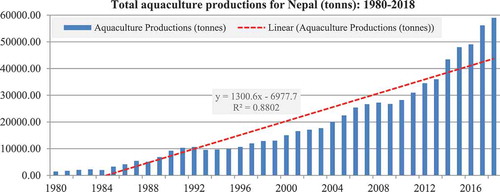
represents the expeditious growth trend of aquaculture production in Nepal in a small period of time. Aquaculture development has increased the trend of fisheries production in Nepal. The annual aquaculture production tends to increase over the years as shown in the figure.
shows the total fish production of 70,832 tonnes from aquacultural practices in fiscal year 2018/19, of which 62,725 tonnes were from pond fish culture. Similarly, Paddycum fish culture, cage fish culture, enclosure fish culture and Trout fish culture in a raceway are developing in different parts of the country. also reveals the total fish production of 21,000 tonnes from capture fisheries in 2018/19 of which rivers comprise 7,110 tonnes and low land irrigated paddy field comprises 7,165 tonnes. Others include lakes, reservoirs, swamps/marginal lands, etc. From this data, it is known that all the potential rivers and water resources suitable for fish farming should fully be used properly for commercial fish production so that the country can achieve maximum benefit from this enterprise.
Table 1. Nepal fishery production in accordance with sources
Ponds are the most popular systems for aquaculture, but raceways and other flowing water systems, cages, and net pens are also common in Nepal. Water reuse systems aren’t used more, but these systems will probably be more practiced in the future. Some fisheries such as lakes of Pokhara, Terai, and Kathmandu support a commercial harvest that is exported and marketed away from the source. Also, other fisheries generate large quantities of fish, but most of them are consumed locally, so the economic importance is difficult to measure. Fish ponds have potential to increase bird populations, which are mesmerizing to birdwatchers, but are scorned by fish farmers. Globally, all fisheries are imperiled by different factors (Water encylopedia, Citation2018). Environmental degradation, loss of habitat, invasive species, parasites, illegal fishing methods, and overfishing are the major serious issues. While uncontrolled management of fish ponds can make breeding grounds for vectors of animal and human disease, organized fish ponds can be used to control these vectors. Thus, effective farm management helped at minimizing negative environmental impacts.
3.1.2. Global scenario of fish farming
It is implausible today that we could feed the global population by the ancient technique of just hunting and gathering. World demand for fishery products is rising as the health benefits of fish food are known. Nowadays, the consumers are more concerned to know how and where their food, including fish products, has been produced. Fishery production has increased in a last few years, and this trend is supposed to continue into the next decades. In 2018, the marine aquaculture and capture production have levelled at around 100 million metric tonnes as shown in and the contribution of aquaculture has notably increased. Global fish production is assumed to have reached approximately 179 million tonnes (FAOb, Citation2020) in 2018 (). Aquaculture accounted for 46 percent (82.1 million tonnes) of the total production and capture fisheries for 96.4 million tonnes in 2018. The total capture fisheries (Inland plus marine) increased by almost 10 million metric tonnes from 1988 to 2018 within the period of 30 years. Inland fisheries production rate for both capture and aquaculture is increasing than the marine due to the advancement in the realm technology.
Table 2. Production, utilization, and trade at global level
The second part of reveals the human fish consumption of 156 million tonnes in 2018 which is equivalent to an estimated yearly supply of 20.5 kg per capita. The remaining 22 million tonnes were reported as non-food consumptions, majorly to produce fishmeal and fish oil. Per capita fish utilization grew from 13 kg (live weight equivalent) in 1986 to 20 kg in 2016. However, consumption can differ heavily between different areas of the world, from 1 kg to more than 100 kg per person per year. The per capita fish consumption of developing and under-developed countries is still low than the global average. It might be due to less concern of people towards the nutritious foods, poverty, and lack of proper marketing of the fish industry.
Figure 3. Progression in fish farming from 1990–2018 Source: (FAOc, Citation2020)
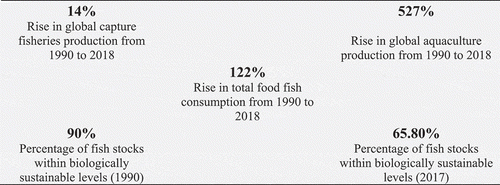
shows the development and changes in fish farming scenario from 1980 to 2018. Conventional fish farming practices were just based on the locally available means and resources. However, with time, along with the development of the human civilization and the transformation of the technologies, the fishery enterprises and the aquaculture sector started taking the profitable way.
3.2. Fish marketing
3.2.1. National scenario of fish marketing
Marketing is a comprehensive term that includes all the interactions involved from the point of production to the distribution of goods to the consumer (Engle & Quagrainie, Citation2006). Market system comprises wholesale market, retail market, and fish retail markets (Gupta & Gupta, Citation2008). The increase in quantity of fish production as well as advancement of fishery sector in terms of economy and infrastructure is profoundly dependent on an efficient fish marketing system (Chourey et al., Citation2014). Local fish markets development in Nepal plays a very important part in the development of aquaculture sector. Fish marketing development in the country is in emerging stage as marketing network has not been well organized in Nepal. There were 1681 markets registered for fish selling and 22,406 farmer’s pond sites, and 69 live fish selling stalls for the selling of live fish in Nepal (NFS, Citation2017). Fish enterprises offer outstanding profitable opportunities as freshwater fish farming is economical to produce and convenient to sell at high price. Fish marketing has become very crucial in distribution of fishery products through efficient and effective marketing channels and it is current need in agriculture-based national economy of Nepal. However, fish marketing has not been able to flourish in Nepal in a systematic way. The fish growers produced fewer quantities of fish products and sell in the town and fulfill their basic needs. Aquacultural marketing works in the interest of individuals which help commercial farmers only and a huge number of small farmers are always deprived of due benefits. Since there are no sufficient and proper storage facilities, whatever the farmers produce are brought to the market immediately after harvesting. This usually causes over-supply in the market compelling the farmers to sell their fish items at unfairly lower price. Fish marketing systems have been well managed in most cities in the southern Terai along with established agriculture marketing channels. These services are used by fish traders at all levels, including middlemen, wholesalers, retailers and vendors on a community and co-operative basis. Overall, the marketing prospects of fish farming are positively developing throughout the different parts of the country.
3.2.1.1. Fish trade: national import and export
Fisheries production in Nepal is mainly utilized by the domestic market. Also, some export happens but this is still limited and imports highly exceed exports (Labh et al., Citation2017). The domestic production of fish is inadequate to fulfill the national demand and there is a high import every year from neighboring countries mainly India. According to (World Bank, Citation2020a), the national GDP of Nepal in 2019 was 30.64 billion USD, of which agriculture and aquaculture share 24.3% (World Bank, Citation2020).
Figure 4. Trend of fish imports value of Nepal in USD Source: (Trend Economy, Citation2020)
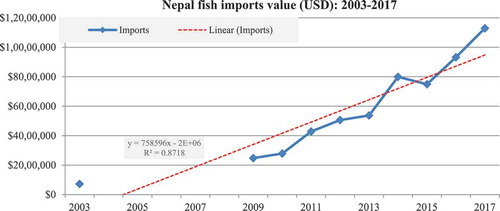
When compared to the import value of fishery products in the past decades, the import has drastically increased in this decade and the import curve has shifted upright as shown in indicating the increasing value of import. also shows the decline in import value in 2015. The plausible explanation beyond the reason for decrease in value was the worst hit of earthquake in Nepal which affected the people’s economic condition to purchase the goods. The import value of fish products increased from 721,786 USD to 11,290,872 USD within the period of 2003–2017. Though endowed with abundant water resources, Nepal still has to import the fish products to meet public demand. The possible reasons for high import might be inappropriate marketing channels of product distribution in the country, influence of large share of national border with India in the south, low cost prices of Indian fish, and lack of production technology and marketing infrastructure in Nepal. Keeping this point in view, there seems an urgent need to cope with these problems in order to reduce the import rate of fish from other countries.
Figure 5. Trend of fish exports value of Nepal in USD Source: (Trend Economy, Citation2020)
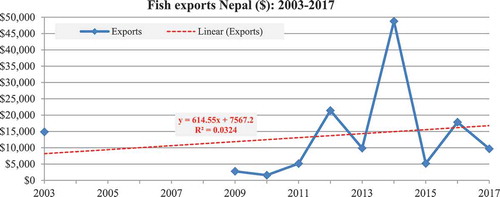
shows the data of fish exports value (USD) by Nepal in different years. The export value of fish from Nepal is very few as compared to the import value. Several constraints have hindered the export progress of Nepal and the consumers are highly relied on the exported food items. shows the export value of 14,872 USD in 2003 which decreased to 9,684 USD in 2017. Unlike import, there is a timely fluctuation in export. The highest export of this decade was observed in 2014 with total value of 48,778 USD. After earthquake hit of 2015 in Nepal, there was brisk decline in export. The Government of Nepal, Ministry of Agriculture and fishery, agricultural council, trade experts, policy-makers, businessmen, and the producers should make effective plans in collaboration with the foreign organizations for increasing the export of fish products.
3.2.1.2. Fish marketing channel in Nepal
Fish marketing channels in Nepal differ from place to place. A number of intermediaries are engaged in the distribution process of fresh fish marketing. Farmers themselves either sell their fish product from the harvesting site or send it to local markets. In case of commercial production, fish is generally distributed through contractors (Mishra & Kunwar, Citation2014; Karki, Citation2016). There are also aquacultural organizations that produce fish and sell them through cooperatives.
The fish marketing channels are listed below:
Fish farmer—middleman/collectors/contractors—commission agents—wholesalers—retailers—consumers
Fish farmer—middleman/collectors/contractors—wholesalers—retailers—consumers
Fish farmer—Fish cooperative/fish entrepreneur committee—consumers
Fish farmer—middleman/collectors/contractors—retailers—consumers
Fish farmer—middleman/collectors/contractors—consumers
Fish farmer—retailors—consumers.
3.2.2. Global scenario of fish marketing
More than one-third of the global fish production is marketed internationally however, in the last decade; the nature of that trade has changed. Globalization and liberalization of markets, accompanied with trade growth in developing countries, increasing domestic demand and the increased significance of fishery production, have had a prodigious impact on the global fisheries and on fish trade (FAOe, Citation2018). Furthermore, as trade has liberalized, the food chain has widened, increasing the need for quality-control management that secures safe produce for consumers.
Figure 6. Top aquaculture-producing countries Source: (BizVibe, Citation2020)
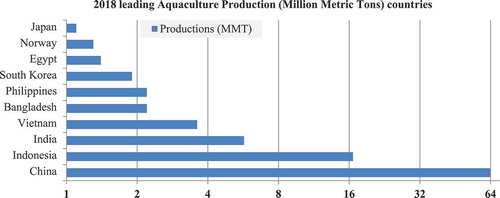
Global fishery production has been dominated by Asia. Among major fishery-producing countries, China, India, Indonesia, Vietnam, Bangladesh, Egypt, Norway and Chile, have ruled their share in global production. China has remained a dominant fish producer, accounting for 64 million tonnes of fish production in 2018. Total fish production has seen rises in all the continents in the last few decades, except Europe and the Americas (BizVibe, Citation2020). The rising production of aquaculture in many developed countries is the motivation and inspiration for many farmers of Nepal to get involved in fish farming.
3.2.3. Fish trade: global import and export
EU (European Union) ranks the largest fish importer in 2018, followed by the USA and China. With the rapid growth in its national fish demand, China’s and USA’s seafood import value is witnessing a strong increase. Today, to reduce import dependence, Chinese farmers are trying to raise salmon and other temperate fish like trout (BizVibe, Citation2020). This should be learned by Nepalese farmers too. By increasing the cultivation practices of many aquacultural species besides fish, Nepal can somehow reduce the import of fish from other countries and increase the export too. Japan, South Korea, Thailand, Canada, Russia, Australia, and Brazil are among the top ten countries of fish importer worldwide in 2018. EU import fish value of almost 61 billion USD, where USA and China import the fish worth of 22.6 billions USD and 20.2 billions USD respectively. shows the import value of different countries in fish import.
Figure 7. Top fish importing countries by import value. Source: (BizVibe, Citation2020)
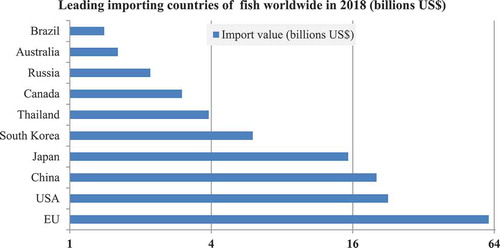
Figure 8. Top fish exporting countries by export value Source: (BizVibe, Citation2020)
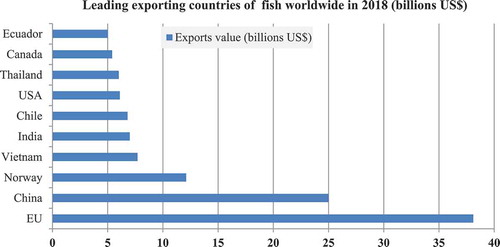
With 38 billion USD value, EU exports the highest value of fish, globally. shows the topmost countries of fish export worldwide in 2018. EU is followed by China with 25 billion USD import value and Norway by 12.1 billion USD. Other leading countries are Vietnam, India, Chile, USA, Thailand, Canada, and Ecuador. It contributes very high share to GDP of the respective nations every year. Fishery has therefore proved a profitable venture in both domestic and international level nowadays. Nepal has very small share of export value when compared to the world’s export scenario.
3.3. Future prospects of fish farming
Fish farming is estimated to provide approximately two-thirds of world food fish consumption by 2030 as catches from capture fisheries level off and demand from an emerging global middle class, particularly in China, substantially increases (Reliefweb, Citation2014). The significance of fishery in improving the diet of the people, creating employment in rural areas, and saving foreign exchange through import substitution, has usually been recognized in most of the developing countries, including Nepal in recent years. Governments have accorded more priority to this sector and commenced development activities. Experimental and limited pilot-scale tests have proved that small- or large-scale fish farming using indigenous species and feeding item can be highly profitable and successful. Fish is one of the healthiest diets being loaded with major nutrients, such as protein and vitamin D and is a great source of omega-3 fatty acids, which are incredibly necessary for human body and brain. Also, it is a noteworthy cultural icon in many countries that defines a recreational as well as a spiritual way of life. It is not just an essential source of nutrition, the act of catching, preparing, and eating fish are good cultural and family practices as well. Fish farming generates business opportunity for entrepreneurs, creates employment for job-seeking citizens, and is such kind of business that can never dry up in the future.
Fish is often accepted and preferred by all non-vegetarian Nepalese. Nepal has countless unused water resources like rivers, lakes, man-made reservoirs, swamps, ponds, and other water bodies favorable for fisheries production. They provide good habitat for fishes. There are numerous species of fishes that can be grown faster and harvested. Entrepreneurs can take advantage of this and explore fast profit-making chances. However, Fish industry is potentially unexplored in Nepal. The existing fish industry is just restricted to rearing fish due to which there are prospects for entrepreneurs in the areas of harvesting, processing, marketing, and distribution of fish. People can invest in these areas and explore the opportunities to increase benefits and help Nepal realize its true potential in the fish enterprise. Overall, it is a profitable occupation and a good source of income in Nepal. The climate and nature of soil and water are suitable for building fish ponds in different parts of the country. As far as water resources are concerned, Nepal has three main rivers; Koshi, Gandaki, and Karnali where many types of fishes are found. Also, there are many lakes in Nepal like Fewa, Rupa, Begnas, Rara, etc., where fishes are cultured. Economic contribution of fish industry, health benefits, employment generation opportunity, rising demands of the consumers, and favorable environmental condition of fish farming have widened the future prospects of fish farming in Nepal.
3.3.1. Global employment in Fisheries
shows the global employment level of people in the sector of Fisheries and Aquaculture. It is estimated that fisheries and aquaculture combined provide employment to 59,509 (’000) farmers worldwide. Asia has the highest number of farmers involved in this industry followed by Africa, Americas, Oceania, and Europe. Nepal, being Asian country, has high prospects for farmers to have engaged in fish industry. From harvesting to distributing, people can be involved in different jobs in different processes. From , it is clearly known that fisheries and aquaculture have provided employment to millions of people worldwide implying the greater future prospects of fish farming in many countries.
Table 3. World employment for Fisheries and fish farmers
3.4. Strategies to get fishery growth right
3.4.1. Production strategies
Provision of technical and financial assistance in order to continue to develop the fishery potential of the country and enhance the optimal production.
Improvements in breeding technology, disease management, proper feeds and nutrition, and low-cost production systems are interlinked areas where science can complement indigenous knowledge to improve efficiency.
Geographical planning and zoning can assure that fishery production can be eco-friendly within the ecosystem’s carrying capacity and can also help in sustainable conservation of the available resources. Norway’s zoning policy, for example, assures that salmon producers are not just over concentrated in one area; it is decentralized lessening disease risk and helping mitigate environmental impacts (Waite, Citation2014).
Development of incentives policy to encourage farmers to produce more fish products. For example, Government of Thailand has provided shrimp farmers with services of free training, water supply, and wastewater treatment. It has also provided loans at low interests and tax exemptions to small-scale producers helping them adopt modern technology that increased productivity (Waite, Citation2014).
Special attention should be given to the conservation of the breeding areas. Developed ecological zones are usually polluted, being disturbed by urban human activities or by uncontrolled fishing. In such areas, protection strategies are necessary to ensure the survival of breeding stocks (Fishing, Citation2018).
Emphasize technologies provision for the poor-level farmers of fisheries at national, regional, and household levels. Extension services, workshops, seminars, and symposium can help farmers to acquire high knowledge regarding technology and the effective way of production.
Strengthen the aquaculture database of fishery production and use it for better planning and policymaking in the sector of improving the production.
Development of fishery in inland ponds and floodplain through fish polyculture and community-based aquaculture and noninvasive species.
3.4.2. Marketing strategies
Marketing in recent decades has gained a lot of importance because of rapid economic growth, globalization, technological upgradation, ever-increasing human needs and wants, and increasing purchasing power of people. Therefore, to succeed in today’s competitive marketplace, producers must be customer centered. The best strategies of marketing any commercial goods are shown by 7 P’s of marketing mix as shown in .
Figure 9. Marketing strategies showing 7 P’s variables
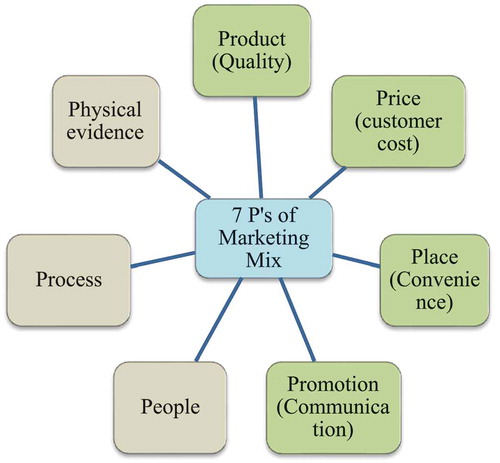
The term “marketing mix” is a mix of marketing strategy for various commercially produced goods. The marketing mix is defined as the set of actions, or strategies, that a producer uses to promote its product in the market (The Economic Times, Citation2020). The first P i.e. Product () refers to the fish items actually being sold in case of fish marketing. These items must deliver the minimum level of satisfaction to the consumers, must be of quality, delicious, healthy, and fresh in order to get the profitable market. The second P, i.e., Price refers to the price of the fish that the customers have to pay for. The price must be fixed according to the attributes and quality of products, must be affordable; much high price makes the customers shift towards the substitute foods like meats, eggs, and other dietary products. Also, much less price makes the seller bear loss. So, the price of product must be fixed at optimum. The third P, i.e. Place, refers to the area of marketing. The market must be established in such an area which is accessible to the majority of the public, the infrastructure of the market place must be better, marketing channels should be well-understood, and wholesalers and retailers must be designed conveniently. The fourth P, i.e., Promotion, which includes all the strategies undertaken to make the product known to the consumer and traders. Strategies are needed to combine individual methods such as advertising, personal selling, and sales promotion into a particular campaign. These 4 P’s, i.e., Product, Price, Place, and Promotion, are the strategies of marketing mix.
In addition, nowadays other 3 Ps, i.e., People, Process, and Physical evidence, have been added to the list. People means all the actors involved in the marketing channels that, for the successful marketing, must show the ethical behavior and influence the buyer’s perception. Process refers to the procedures of activities from harvesting of fish to the delivery to the customers. This process must go well throughout the entire path so that the consumers get maximum satisfaction after consumption. Finally, physical evidence is the environment in which the market offering is delivered and where the seller and buyer interact. All the elements of the marketing mix influence each other directly or indirectly. They make up the marketing plan for an enterprise and handled right, can give it great success. The marketing mix, therefore, can be proved to be the best marketing strategies for the fish growers, traders, and marketers.
3.4.3. SWOT analysis
SWOT analysis determined the strength, weakness, opportunity, and threat, where strength and weakness describe external factors affecting fish production, while threat and opportunity comprise external factors governing fishery industry (Table 5). Researchers, aquacultural agencies, and policy makers must emphasize on weakness and threats while designing a plan for sustainable production and marketing of fishery products.
Table 4. SWOT analysis of Fish production and marketing
4. Conclusions
Though the global fish production is in increasing trend, it is not able to fulfill the demand of continuously increasing population worldwide. Aquaculture and fishery have contributed to large share of GDP both globally and nationally. It will assure nutritional and food security as well as minimizing post-harvest losses, contribute to revenue, increase employment opportunities and supply hygiene fish. The future prospects of fish farming can also be seen as a part of providing employment to millions of people worldwide. While global fish production for inland water resources was 63 million metric tons in 2018, Nepal had 59,000 tons of total inland fish production. However, Nepal has to still export the fish from other countries to meet the national demand. The export rate is far low than the import value. Majorly, Nepal export from India. In 2018, China was the most fish-producing countries followed by Indonesia, India, Vietnam, and Bangladesh; EU was the top importers followed by USA, China, Japan, and South Korea; China was the top exporters followed by Norway, Vietnam, India, and Chile. With prospects, there are many challenges in the sector too. Overall fish productivity had not been satisfactory in terms of marketing and production. Market infrastructure, storage facilities, insulated vehicles, price control, and provision of incentives, trainings, extension programs, and offsite fish market should be facilitated. Different agricultural organizations, aquacultural agencies, trade experts, policy-makers, and producers should make plans and strategies in order to make the fishery flourish profitably. Also, farmers should be encouraged to adopt modern technology of fish culture, practicing polyculture, Paddycum fish culture, and so on. The marketing networks must be well managed so that no producers get economic loss after production.
4.1. Future research works
The authors recommend that future research endeavors should include in-depth studies on commercial fish farming so that the nation would get maximum benefit. The conducted review can be applied to improve aquacultural sector through the effective marketing and production technology. Future research should be focused on motivating the farmers making them understood the production, marketing, and prospects of fish culture in Nepal. Training and extension programs in Nepal have been limited in scope. Initiatives such as extension services, seminars, and aquacultural programs to make farmers educated should be developed. It is hoped that the findings of this study present clear insights into efforts that will encourage farmers to involve in fish production and marketing through improved technology and means.
Disclosure statement
The author declares no conflicts of interest regarding publication of this manuscript.
Additional information
Funding
Notes on contributors
Saugat Khanal
Saugat Khanal is an agricultural research scholar and author. He has worked as an assistant in various agricultural projects and has written, about the Behavioral economics, Consumer’s Willingness to Pay (WTP), Invasive pests, Technology adoption, Precision Agriculture, Supply chain management, Agritourism, etc., to many national and international journals. Currently, he is working on the project “Transforming Economies through Youth involvement in Farming”.
Sushil Khatri is a young researcher and youth activist. His area of interest includes pest management, sustainable agriculture, applied economics, and statistics. Currently, he has been working as the Local Director of International Association of students in Agriculture and Related Sciences (IAAS), Nepal LC at Agriculture and Forestry University.
Saurav Khanal is a student of Chartered Accountant and also a student of Bachelor of Business Studies. He has published about the trade deficit, marketing, accountancy, and macroeconomics to the newspapers and the journals. Currently, he has been working as an Article Assistant at B.K. Agrawal and Company, Chartered Accountants.
References
- BizVibe. (2020, January). Food & beverages. Global Aquaculture Industry Factsheet 2020: Largest Seafood Producing Countries, Largest Seafood Exporters and Importers. Retrieved August 27, 2020, from https://www.bizvibe.com/blog/food-beverages/largest-seafood-producing-countries/#:~:text=China%20came%20in%20second%20at,Norway%2C%20Vietnam%20and%20the%20India
- Bogati, N. (2018, September 24). Fish Industry in Nepal. Retrieved from Biruwa Advisors.
- Britannica. (2020, August 21). Retrieved August 26, 2020, from Nepal: https://www.britannica.com/place/Nepal
- Chourey, P., Meena, D., Varma, A., & Saxena, G. (2014). Fish marketing system in bhopal. Biological Forum –An International Journal, 6(1), 19–19. https://www.researchtrend.net/bfij/bf12/4%20PRATIBHA%20CHOUREY.pdf
- The Economic Times. (2020). Marketing mix. Retrieved September 3, 2020, from https://economictimes.indiatimes.com/definition/marketing-mix
- Engle, C., & Quagrainie, K. (2006). Aquaculture marketing handbook. Blackwell Publishing Professional.
- FAOa. (2020). National aquaculture sector overview: Nepal. Food and Agriculture Organization of the United Nations. Retrieved August 26, 2020, from http://www.fao.org/fishery/countrysector/naso_nepal/en
- FAOb. (2020). Sustainability in action. The state of world fisheries and aquaculture. Retrieved August 27, 2020, from http://www.fao.org/3/ca9229en/ca9229en.pdf#page=20
- FAOc. (2020). The state of world fisheries and aquaculture 2020. Retrieved August 28, 2020, from http://www.fao.org/state-of-fisheries-aquaculture
- FAOd. (2019). Food and Agriculture Organization of the United Nations. Understanding and measuring the contribution of aquaculture and fisheries to gross domestic product (GDP). Retrieved August 31, 2020, from http://www.fao.org/3/CA3200EN/ca3200en.pdf
- FAOe. (2018). Establishing and linking global fish-trade information networks. Retrieved September 2, 2020, from http://www.fao.org/in-action/establishing-and-linking-global-fish-trade-information-networks/en/
- Fish site. (2020, June 8). A new high for global aquaculture production. Retrieved August 31, 2020, from https://thefishsite.com/articles/a-new-high-for-global-aquaculture-production
- Fishing. (2018). Strategies for fish production. Retrieved September 3, 2020, from http://www.fao.org/3/ac997e/AC997E09.htm
- Gupta, S., & Gupta, P. (2008). General and applied ichthyology (Fish and Fisheries). S. Chand and Company LTD.
- Karki, N. (2016). Fish farming in Nepal: Trends, opportunities, and constraints. Nepalese Journal of Agricultural Sciences, 14, 201–210. http://www.hicast.edu.np/uploads/colleges/16/582eab6d9e293.pdf
- Labh, S. N., Kayastha, B. L., Shakya, S. R., Kushwaha, M. P., Vaidya, S. R., Chitrakar, P., Dhital, K. S. (2017). Present status and future prospectives of freshwater fisheries in Nepal: A short overview. International Journal of Fisheries and Aquatic StudieS, 5(3), 95–97. https://www.fisheriesjournal.com/archives/2017/vol5issue3/PartB/5-2-69-323.pdf
- Mishra, R., & Kunwar, P. (2014). Status of Aquaculture in Nepal. Nepalese Journal of Aquaculture and Fisheries, 1, 1–17.
- MoAD. (2020). Statistical information on Nepalese agriculture 2075/76 (2018/19). Ministry of Agriculture and Livestock Development. Retrieved September 3, 2020, from https://s3-ap-southeast-1.amazonaws.com/prod-gov-agriculture/server-assets/publication-1595229368881-0dc12.pdf
- NFS. (2017). National fishery survey. Central Bureau of Statistics Kathmandu, Nepal. Retrieved September 1, 2020, from http://cbs.gov.np/image/data/2017/Nepal%20Fishery%20Survey%202072%20Report.pdf
- Reliefweb. (2014, February 5). Fish to 2030: Prospects for Fisheries and aquaculture. Retrieved September 2, 2020, from https://reliefweb.int/report/world/fish-2030-prospects-fisheries-and-aquaculture#:~:text=The%20report%20predicts%20that%2062,year%20between%202010%20and%202030
- Rivers and Soul. (2019). Rivers of Nepal. Retrieved August 31, 2020, from https://www.riverandsouladventures.com/rivers-of-nepal/
- Shrestha, M. K. (2018). Aquaculture development in Nepal and current needs. Retrieved August 31, 2020, from Cinepal: http://www.cainepal.org.np/sites/default/files/Aquaculture%20Development%20in%20Nepal%20and%20Current%20Needs_0.pdf
- Trend Economy. (2020, February 10). Annual International Trade Statistics by Country. Retrieved August 27, 2020, from https://trendeconomy.com/data/h2?commodity=03&reporter=Nepal&trade_flow=Export,Import&partner=World&indicator=NW,TQ,TV&time_period=2002,2003,2004,2005,2006,2007,2008,2009,2010,2011,2012,2013,2014,2015,2016,2017,2018,2019
- Waite, R. (2014, June 4). Sustainable fish farming: 5 strategies to get aquaculture growth right. World Resources Institute. Retrieved September 3, 2020, from https://www.wri.org/blog/2014/06/sustainable-fish-farming-5-strategies-get-aquaculture-growth-right
- Water encylopedia. (2018). Fisheries, Fresh-Water. Science and Issues. Retrieved September 1, 2020, from http://www.waterencyclopedia.com/En-Ge/Fisheries-Fresh-Water.html
- World Bank. (2020). IBRD-IDA. Retrieved August 21, 2020, from https://data.worldbank.org/indicator/NV.AGR.TOTL.ZS?end=2019&locations=NP&start=1965&view=chart
- World Bank. (2020a). Trading economics. Retrieved August 26, 2020, from Nepal: https://tradingeconomics.com/nepal/gdp#:~:text=GDP%20in%20Nepal%20is%20expected,according%20to%20our%20econometric%20models
- World Bank. (2020b). Trading economics. Retrieved August 26, 2020, from Nepal GDP per capita: https://tradingeconomics.com/nepal/gdp-per-capita#:~:text=GDP%20per%20capita%20in%20Nepal%20is%20expected%20to%20reach%20830.00,according%20to%20our%20econometric%20models
- WorldFish Center. (2011, December). Aquaculture, Fisheries, Poverty and Food Security. Retrieved August 31, 2020, from http://pubs.iclarm.net/resource_centre/WF_2971.pdf
- Worldometer. (2020). Nepal Population. Retrieved August 26, 2020, from https://www.worldometers.info/world-population/nepal-population/

